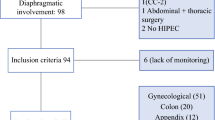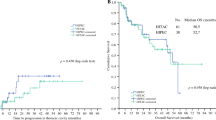Abstract
Background
Pleural recurrence after cytoreductive surgery (CRS) and hyperthermic intraperitoneal chemotherapy (HIPEC) is rare and poorly delineated. Specifically, data are limited on the effect that diaphragmatic peritoneal stripping versus full-thickness resection has on the nature of ipsilateral pleural recurrence and postoperative morbidity.
Methods
Patients with peritoneal carcinomatosis who underwent CRS/HIPEC were included from a prospectively maintained database. The patients were divided into three cohorts based on surgical management of the diaphragm as follows: diaphragm-stripping (DS) cohort, full-thickness resection (FTR) cohort, and no diaphragm manipulation (ND) cohort. Postoperative morbidity and incidence of ipsilateral pleural recurrence were evaluated. All diaphragmatic defects were closed before abdominal chemoperfusion.
Results
The inclusion criteria were met by 409 CRS/HIPEC procedures: 66 in DS, 122 in FTR, and 238 in ND. Ipsilateral pleural recurrence rates did not differ significantly between the three cohorts (DS 6%, FTR 3%, ND 3%; p = 0.470). Postoperative respiratory complications and overall morbidity were significantly greater for the patients who underwent diaphragmatic disruption (stripping and/or resection) than for the patients who did not (p ≤ 0.0001), but the two groups did not differ in terms of 30-day mortality. However, comparison of FTR with DS showed no impact on major morbidity or pleural recurrence.
Conclusion
Although patients undergoing surgical manipulation of the diaphragm during CRS/HIPEC experienced significantly greater morbidity, diaphragmatic stripping did not differ from full-thickness resection in terms of grades 3 and 4 complications or incidence of ipsilateral pleural recurrences. When deemed necessary to achieve complete cytoreduction, full-thickness diaphragmatic resection should be undertaken. In addition, the data support the observation that definitive repair of the diaphragmatic defect before abdominal chemoperfusion does not adversely influence ipsilateral pleural recurrence.
Similar content being viewed by others
References
Kuncewitch M, Levine EA, Shen P, Votanopoulos KI. The role of cytoreductive surgery and hyperthermic intraperitoneal chemotherapy for appendiceal tumors and colorectal adenocarcinomas. Clin Colon Rectal Surg. 2018;31:288–94. https://doi.org/10.1055/s-0038-1642052.
Sugarbaker PH. Peritoneal metastates: a fronteir for progress. Surg Oncol Clin North Am. 2018;27:413–24. https://doi.org/10.1016/j.soc.2018.02.001.
Zivanovic O, Chi DS, Filippova O, Randall LM, Bristow RE, O’Cearbhaill RE. It’s time to warm up to hyperthermic intraperitoneal chemotherapy for patients with ovarian cancer. Gynecol Oncol. 2018;151:555–61. https://doi.org/10.1016/j.ygyno.2018.09.007.
Franssen B, Tabrizian P, Weinberg A, Romanoff A, Tuvin D, Labow D, Sarpel U. Outcome of cytoreductive surgery and hyperthermic intraperitoneal chemotherapy on patients with diaphragmatic involvement. Ann Surg Oncol. 2015;22:1639–44. https://doi.org/10.1245/s10434-014-4083-x.
Shen P, Levine EA, Hall J, et al. Factors predicting survival after intraperitoneal hyperthermic chemotherapy with mitomycin C after cytoreductive surgery for patients with peritoneal carcinomatosis. Arch Surg. 2003;138:26–33.
Van Sweringen HL, Hanseman DJ, Ahmad SA, Edwards MJ, Sussman JJ. Predictors of survival in patients with high-grade peritoneal metastases undergoing cytoreductive surgery and hyperthermic intraperitoneal chemotherapy. Surgery. 2011;152:617–24. https://doi.org/10.1016/j.surg.2012.07.027.
Votanopoulos KI, Bartlett D, Moran B, et al. PCI is not predictive of survival after complete CRS/HIPEC in peritoneal dissemination from high-grade appendiceal primaries. Ann Surg Oncol. 2018;25:674–8. https://doi.org/10.1245/s10434-017-6315-3.
Sugarbaker PH, Chang D, Stuart OA. Hyperthermic intraoperative thoracoabdominal chemotherapy. Gastroenterol Res Pract. 2012:1–7. https://doi.org/10.1155/2012/623417.
Ahmed S, Levine EA, Randle RW, Swett KR, Shen P, Stwart JH, Votanopoulous KI. Significance of diaphragmatic resections and thoracic chemoperfusion on outcomes of peritoneal surface disease treated with cytoreductive surgery (CRS) and hyperthermic intraperitoneal chemotherapy (HIPEC). Ann Surg Oncol. 2014;21:4226–31. https://doi.org/10.1245/s10434-014-3891-3.
Grotz TE, Mansfield PF, Royal RE, et al. Intrathoracic chemoperfusion decreases recurrences in patients with full-thickness diaphragm involvement with mucinous appendiceal adenocarcinoma. Ann Surg Oncol. 2016;23:2914–9. https://doi.org/10.1245/s10434-016-5209-0.
Pestieau SR, Esquivel J, Sugarbaker PH. Pleural extension of mucinous tumor in patients with pseudomyxoma peritonei syndrome. Ann Surg Oncol. 2000;7:199–203.
Beane JD, Wilson GC, Sutton JM, et al. Pleuropulmonary recurrence following cytoreductive surgery and hyperthermic intraperitoneal chemoperfusion for appendiceal pseudomyxoma peritonei. Ann Surg Oncol. 2019;1429–36. https://doi.org/10.1245/s10434-018-07091-z.
Tabrizian P, Shrager B, Jibara G, et al. Cytoreductive surgery and hyperthermic intraperitoneal chemotherapy for peritoneal carcinomatosis: outcomes from a singe tertiary institution. J Gastrointest Surg. 2014;18:1024–31. https://doi.org/10.1007/s11605-014-2477-5.
Jacquet P, Sugarbaker PH. Clinical research methodologies in diagnosis and staging of patients with peritoneal carcinomatosis. In Sugarbaker PH (ed) Peritoneal carcinomatosis: principles of management. Boston: Kluwer Academic Publishers; 1996, pp 359–374.
Sugarbaker PH. Cytoreductive surgery and perioperative intraperitoneal chemotherapy as a curative approach to pseudomyxoma peritonei syndrome. Eur J Surg Oncol. 2001;27:239–43.
Levine EA, Steward JH IV, Shen P, Russell GB, Loggie BL, Votanopoulos KI. Intraperitoneal chemotherapy for peritoneal surface malignancy: experience with 1000 patients. J Am Coll Surg. 2014;218:573–85. https://doi.org/10.1016/j.jamcollsurg.2013.12.013.
Downs-Canner S, Ding Y, Magge DR, et al. A comparative analysis of postoperative pancreatic fistulas after surgery with and without hyperthermic intraperitoneal chemoperfusion. Ann Surg Oncol. 2015;22:1651–7. https://doi.org/10.1245/s10434-014-4186-4.
Glehen O, Gilly FN, Boutitie F, et al. Toward curative treatment of peritoneal carcinomatosis from nonovarian origin by cytoreductive surgery combined with perioperative intraperitoneal chemotherapy: a multi-institutional study of 1290 patients. Cancer. 2010;116:5608–18. https://doi.org/10.1002/cncr.25356.
Glehen O, Kwiatkowski F, Sugarbaker PH, et al. Cytoreductive surgery combined with perioperative intraperitoneal chemotherapy for the management of peritoneal carcinomatosis from colorectal cancer: a multi-institutional study. J Clin Oncol. 2004;15:3284–92.
Verwaal VJ, van Ruth S, de Bree E, van Sloothen GW, van Tinteren H, Boot H, Zoetmulder FA. Randomized trial of cytoreduction and hyperthermic intraperitoneal chemotherapy versus systemic chemotherapy and palliative surgery in patients with peritoneal carcinomatosis of colorectal cancer. J Clin Oncol. 2003;21:3737–43.
Verwaal VJ, Bruin S, Boot H, van Slooten G, van Tinteren H. 8-Year follow-up of randomized trial: cytoreduction and hyperthermic intraperitoneal chemotherapy versus systemic chemotherapy in patients with peritoneal carcinomatosis of colorectal cancer. Ann Surg Oncol. 2008;15:2426–32. https://doi.org/10.1245/s10434-008-9966-2.
van Driel WJ, Koole SN, Sonke GS. Hyperthermic intraperitoneal chemotherapy in ovarian cancer. N Engl J Med. 2018;378:1363–4. https://doi.org/10.1056/nejmc1802033.
Yan TD, Deraco M, Baratti D, et al. Cytoreductive surgery and hyperthermic intraperitoneal chemotherapy for malignant peritoneal mesothelioma: multi-institutional experience. J Clin Oncol. 2009;27:6237–42. https://doi.org/10.1200/jco.2009.23.9640.
Youssef H, Newman C, Chandrakumaran K, Mohamed F, Cecil TD, Moran BJ. Operative findings, early complications, and long-term survival in 456 patients with pseudomyxoma peritonei syndrome of appendiceal origin. Dis Colon Rectum. 2011;54:293–9. https://doi.org/10.1007/dcr.0b013e318202f026.
Singh B, Singh G, Alzhrani N, Arrowaili A, Morris D. Long-term survival and perioperative propensity score matched outcomes in diaphragmatic interventions in cytoreductive surgery and intra-peritoneal chemotherapy. Eur J Surg Oncol. 2019;45:620–4. https://doi.org/10.1016/j.ejso.018.2.021.
Chen WJ, Yuan SF, Yan QY, et al. Intrapleural chemo- and hyperthermotherapies for malignant pleural effusion: a randomized prospective study. Cancer Invest. 2012;30:126–130. https://doi.org/10.3109/07357907.2011.633292.
Mujoomdar AA, Sugarbaker DJ. Hyperthermic chemoperfusion for the treatment of malignant pleural mesothelioma. Semin Thorac Cardiovasc Surg. 2008;20:298–304. https://doi.org/10.1053/j.semtcvs.2008.11.002.
Author information
Authors and Affiliations
Corresponding author
Ethics declarations
Disclosures
The authors have nothing to disclose. This research did not receive any specific grant from funding agencies in the public, commercial, or not-for-profit sectors.
Additional information
Publisher's Note
Springer Nature remains neutral with regard to jurisdictional claims in published maps and institutional affiliations.
Rights and permissions
About this article
Cite this article
Sullivan, B.J., Bekhor, E.Y., Carpiniello, M. et al. Diaphragmatic Peritoneal Stripping Versus Full-Thickness Resection in CRS/HIPEC: Is There a Difference?. Ann Surg Oncol 27, 250–258 (2020). https://doi.org/10.1245/s10434-019-07797-8
Received:
Published:
Issue Date:
DOI: https://doi.org/10.1245/s10434-019-07797-8




